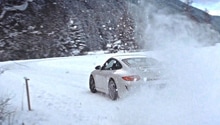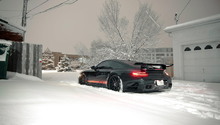Porsche 997: Winter Driving in Your 911
There are several considerations to make beforehand, but driving your 997 in winter can be as successful as it is rewarding. Maybe not the right car to tackle the frozen tundra, but around town? No problem at all.
This article applies to the Porsche 997 (2005-2012).
The automotive tides have turned. More and more models are popping up with available, or even standard, all-wheel drive systems. We can mostly thank Subaru and Audi for starting that trend, but for years now we have been told that if you want to be safe in winter, you need a mid-sized to large car or SUV, with the engine in the front, active or mechanical all-wheel drive and all the electronic bells and whistles to keep you safe from the elements. So what would happen if one were to defy modern logic and take something else out in the snow? Something with only two-wheel drive? Something that looks like an elegant swept-back coupe? Something with the engine in the back? Well, prepare it right, and your 997 can be a joy to drive, come rain, shine, or even snow. Just make sure you do this simple prep first.
Winter Prep Breakdown
Maintenance
Often overlooked, having fresh antifreeze in your car is paramount before even thinking about winter driving. Antifreeze actually has a number of different jobs inside the engine; it lubricates the water pump, prevents corrosion that plain water would allow, and, most importantly for this topic, lowers the freezing point of the liquid to ensure that your car will be safe below 32 degrees. What would happen if the water froze? Well, it wouldn't be pretty. As we know, water expands when frozen, and since your cooling system is closed and sealed, something's gotta give. Usually, this results in burst coolant lines, or worst case scenario, cracked blocks or heads – not a good thing to deal with first thing in the morning.
So what should you do? If you are into DIY, this is a job you could tackle yourself with the right tools. If not, this is a typical, routine maintenance item for any shop that understands Porsche. It's recommended by the factory to have the antifreeze flushed and replaced every three years. Even if it looks fresh, the important additives that allow it to do its job could be depleted. It's also a good time to check and top off your other fluids, just in case. Better safe than sorry!
Another consideration in freezing weather is the battery. The colder it is, the less effective your battery becomes. According to AAA, it can lose as much as 60% of its capacity, so make sure yours is in top shape. If it's marginal while it's warm out, it could leave you stranded when it's cold.

Winter Tires
Once you know your car is mechanically sound, it's time to tackle the tires. This topic gets discussed to death on forums all over the internet, but the simple fact of the matter is this: the only tires designed to work properly in snow, ice, and below freezing temperatures are winter tires. Not summer tires, and not even all-seasons. With proper rubber, you will be able to stop faster, corner better, and get up hills without the drive wheels breaking loose. Of course, this isn't a free ticket to drive like a maniac – there is still significantly less traction than in the dry, but at least you can calm your nerves a bit when the car isn't constantly trying to slip and slide without warning. Think having a C4 or C4S exempts you? Think again. While AWD will help you accelerate in sub-optimal conditions, it does NOT assist with steering or braking, so you still need the right tires for the job.

Common Questions
If my engine is in the "wrong place," will that affect the way it handles snow?
Absolutely! In fact, arguments could be made that having the engine in the back is better for winter driving, especially in two-wheel-drive models. Having all of the weight over the drive wheels gives them more traction, so you are less likely to lose grip. It's not uncommon for owners of front engine-rear drive cars and trucks to put sandbags in the back to help out in winter months. Porsche has just been kind enough to do this for you. How considerate!
Isn't this hard on the car? What about resale value?
It's true: snowy and sloshy roads can be hard on the underpinnings of a car, especially when you throw salt into the mix. Modern cars, the 997 included, have much better anti-corrosion undercoating than they had in the past, so as long as you don't damage that layer while being careless with a jack or running over something solid, and make sure to rinse it down every week or so, the car should come out just fine. Winter driving could affect resale value, but at the end of the day, who did you buy the car for? Yourself, or the next owner?
Related Discussions
- 997 Winter Driving Statistics - Rennlist.com
- Driving Your Porsche in Winter - Rennlist.com
- C4 vs. C2 in the Snow - Rennlist.com
- C4 and C2 in Snow States? - Rennlist.com






